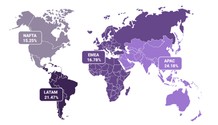Is there anything more annoying in summer than trying to take a swig of your pint, a bite of your apple, or a lick of your ice cream without wasps buzzing about your business?
This was the scene in the picture below, taken around August 2019. I couldn’t relax with half a dozen of the pesky things trying to share my Peroni. So I decided to take drastic, but ultimately futile, action with a tea towel.
Wasps care not for the brand of beer you’re drinking. Whether you’re munching on a Granny Smith or a Braeburn. Or if you prefer mint choc chip flavored ice cream to strawberry and vanilla.
Where there is sugar, there are wasps. And there ain’t nothing you can do about it.
Where There Is Internet, There Is Ad Fraud
We’re not talking about your standard scam here like a poorly constructed SMS with a dodgy link or a phone scam from con artists masquerading as your Bank Manager.
Ad fraud transcends geographic borders, social platforms and targets any industry it pleases.
Because of the size and scale of the internet and the way online advertising networks are constructed, ad fraud is an inevitability, with cleverly designed schemes swarming to popularity.
Like wasps on a sugary treat.
It doesn’t matter if you live in the US, China, or Russia. Whether Google is your search engine of choice. Or if it’s Baidu, Naver, or Yandex that are the dominant platforms where you are. Ad networks that haven’t even been created yet will have this problem.
Here’s a breakdown of how ad fraud looks globally. Our research shows that the Asia-Pacific region sees the highest levels of click fraud due to the rapid rate at which it is growing. Want more of the nitty-gritty data? Take a look at our annual Click Fraud Report.
How Baidu, Naver, And Yandex Stack Up
Just as Google rules the roost in western countries, Baidu, Naver, and Yandex do the same within their respective countries. That’s why, if you’re targeting a specific audience or region that uses a different platform than Google, it’s a good idea to expand the networks you typically run ads on. Let’s look at some stats on each platform to get a flavor for the potential scale of ad fraud.
Baidu
With a 72.37% domestic market share, Baidu is by far China’s largest search engine platform, reporting 580 million monthly users.
Baidu is made of two segments – Baidu Core, which focuses on keyword-based marketing. And iQiyi, which provides online advertising services.
Naver
Naver is the search engine platform in South Korea, with an estimated 40 million monthly users – relative to its population of 51.8 million, it stands well clear of the competition. The website and app are a hub for lots of other features, too, like a dictionary, translation tools, and webcomics, to name a few.
Yandex
With an estimated 84 million users monthly, Yandex is Russia’s biggest search engine and web portal provider. It also offers services similar to what you’d get on Google, with features like maps, navigator, public transport, weather, and news.
Whether you’ve heard of these platforms or not, the point is that ad fraud isn’t unique to any one.
This was made evident in 2019 when an investigation by online media giants Buzzfeed found that six apps developed by DO Global, a spin-off of Baidu and available in Google’s Play Store, had been fraudulently clicking on ads to generate revenue.
It went on to say that “at least two of them contained code that could be used to engage in a different form of ad fraud,” highlighting how multifaceted these attacks can be.
The apps in this example had over 90 million downloads. DO Global has a reach of over 800 million users. Tempting numbers and untapped revenue for those engaged in criminal activity.
The Surprise Number One
What would you say if you were on a game show and were asked: “what makes the most money for organized crime?”
Your first thought, like many, might be drugs. Maybe the arms trade or trafficking of some kind. They’re all reasonable answers.
But it might (or might not, now you’ve read this article) surprise you to know that it’s ad fraud that sits at the top of the tree.
Yep, as a result of increasingly sophisticated design, newer technologies, and the speed at which ad fraud can be scaled, $67bn is lost annually, with the average individual ad fraudster making an eye watering $5-20 million dollars each year too.
One of the newer technologies is bots that pretend to be people and act like people, even inside mobile games. A bot, winning a level, in a game for humans. And that’s just one example of bot fraud, which makes up 38% of all online fraudulent activity worldwide.
Combining that with the potential reach we’ve just mentioned, advertisers have a steep hill to climb. But all is not lost.
What This Means For You
Don’t let this put you off expanding your business into other territories. There are things you can do to minimize your risk against it.
Firstly, you don’t have to go into new platforms blind. You can build invalid audiences off your current performance on the platforms you’re already using, and then push these to platforms you’re yet to run ads on. If you’d like to know more about how this works, get in touch with your experts.
You can also get rid of the headache that is fraudulent clicks entirely by blocking them. Our click fraud prevention platform works across all platforms, including Baidu, Yandex, and Naver, so if you’re already advertising on there, we’ve got you covered.
Can’t do anything about the wasps, though. Sorry about that.
Get Rid Of The Wasps In Your Sales Funnel
Invalid traffic will keep on stinging you until you do something about it







